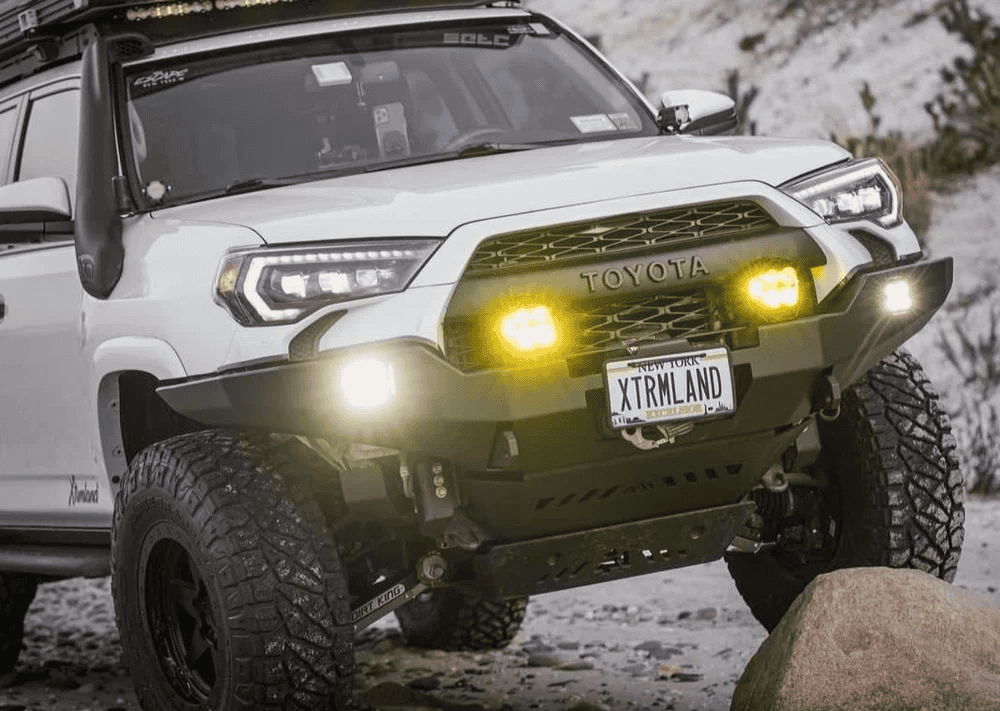Overland Vehicles

A purpose built bumper does three jobs. It safeguards critical components, creates stable recovery points, and keeps your approach angle intact. Done right, it spreads loads into the frame using bracketry with proper gussets and hardware, not just cosmetic cover plates. Good designs maintain airflow for engine and transmission cooling and accommodate lighting, antennas, and a winch without blocking service access.
Bumper geometry matters. Short overhangs, tapered ends, and high corners improve obstacle clearance while reducing hang ups in ruts and ledges. Mounting should tie into multiple frame planes, not just the face, to resist bending under angled pulls. Recovery points need closed eyelets or shackle tabs made from thick plate or machined steel, welded on both sides and backed by the frame.
Approach angle determines whether your tires reach the obstacle before metal does. A compact bumper that hugs the grille and rises at the wings helps the tires climb rather than plow. If you add a bull bar or grille guard, keep it tight to the body to avoid creating a trail plow.
Choosing a winch starts with weight. A common rule is one and a half times the gross vehicle weight rating. Heavier builds with armor, roof gear, and water may need the next size up. Consider line speed under load, duty cycle for long pulls, and planetary gear durability. Waterproofing and sealed electronics are valuable when fording creeks or dealing with winter slush.
Control options include wired remotes for simplicity and wireless for convenience. A clutch you can reach with gloves is more than nice to have when you are kneeling in mud. Make sure the winch drum sits centered in the fairlead opening to prevent rope chafing, and verify your bumper winch tray is rated for the winch capacity.
Synthetic rope is lighter, safer under tension, and easier to handle, but it needs protection from abrasion and UV. Steel cable is more abrasion resistant and tolerant of heat but stores more energy and can recoil if it fails. Use a hawse fairlead with synthetic and a roller fairlead with cable. Inspect often and retire any line with glazed fibers, broken strands, or crushed coils.
Additions at the nose change handling. Extra weight may require firmer springs or revised preload to restore ride height and bump stop clearance. A heavier winch can shift balance forward, so confirm alignment and damping to keep steering feel predictable at highway speed and on washboard.
Electrical planning is as critical as the winch itself. Size power and ground cables according to manufacturer guidance and run the shortest, cleanest path you can. Use quality lugs, crimp tools, and heat shrink. Protect the system with a high amp fuse or breaker near the battery and ensure all grounds are to clean, bare metal. If you run dual batteries, include an isolator or DC to DC charger to safeguard the starting battery.
Voltage drop robs pulling power. Heavy gauge cables, solid chassis ground, and corrosion resistant connections keep amperage where it belongs. Remote mount control packs can reduce heat soak and free space in tight bumpers. Weatherproof your connectors and add loom where lines contact metal edges.
Your first pull should not be your first lesson. Practice safe rigging at home with a tree saver, rated shackles, and a damper on the line. A snatch block doubles pulling power and lets you redirect line to pull more in line with the vehicle. Keep gloves in the recovery kit and spool under tension to avoid loose layers that bite into lower wraps during a load.
Pre trip checks catch problems early. Verify fastener torque on bumper mounts, check recovery points for cracks, and test the winch in and out for a few feet. Carry spare line hardware, a soft shackle, and a short abrasion sleeve for sharp rock contact. After a muddy pull, rinse the rope, dry it, and rewind it with steady tension.
If your setup calls for precise fitment, clean wiring, and mounts that will not budge, partner with a specialist. Our team builds vehicles for real travel and sets bumpers, winches, lighting, and communications up to work as a system. Explore our approach to complete trail ready builds with our Overland rigs page at Overland rigs. For tailored fabrication, wiring, and recovery planning, see Custom overland upfit. Curious about process, craftsmanship, and what it is like to work with us. Start here at Why choose OZK Customs.
We build and deliver from Fayetteville Arkansas, a central hub that makes pickup easy. When your build is ready, you get a full walkthrough and time to test everything before you point the hood toward open country.
Tell us how you travel, how heavy your rig is, and what trails you want to conquer. We will design a bumper and winch package that protects, integrates, and pulls hard when it counts, then install it with proven electrical and structural practices. Your next recovery should be controlled, fast, and safe.
Ready for a build that recovers, protects, and looks purpose built. Tell us about your rig and trails. Our team in Fayetteville will spec the right bumper, winch, wiring, mounts, and accessories, then integrate it cleanly. Start your custom overland upfit now.
ADDRESS:
6159 E Huntsville Rd, Fayetteville, AR 72701
PHONE:
(479) 326-9200
EMAIL:
info@ozkvans.com